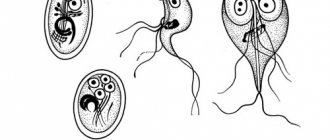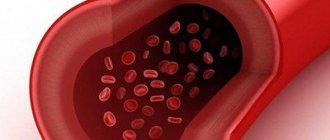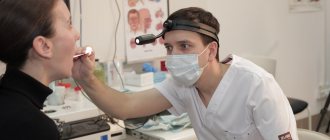Toxocariasis is a parasitic disease that is characterized by a long course, as well as damage to many human organs, that is, multiple organs. This pathology occurs due to the migration in the body of the larval stage of the helminth Toxocara, which can also parasitize dogs and, somewhat less frequently, cats and cattle. Given the peculiarities of the transmission mechanism of this helminth, children are more likely to develop this disease than adults. Children under 10 years of age are especially susceptible to toxocariasis. This can be explained by the fact that this age group has not yet fully developed hygienic skills, and there are also some behavioral features that create conditions for infection with helminths. Toxocariasis occurs everywhere, however, according to statistics, infection with Toxocara is higher among children in rural areas compared to children from cities, which can also be explained by the peculiarity of the mechanism of transmission of the parasite.
Causes of toxocariasis
The immediate cause of the development of this disease is infection of the child with the worm Toxocara. Invasion occurs as follows: the helminth parasitizes in the body of a dog or cat (its main host); along with the feces, the animal releases Toxocara eggs, which fall into the ground. Such soil becomes contaminated with parasite eggs. Invasion occurs when eggs are ingested due to the following factors:
- Failure to comply with basic hygiene rules . Unwashed hands, especially after playing in the sandbox or touching the ground, are the most common cause of helminth infection.
- Behavioral characteristics of the child . Geophagy (eating soil) and nail biting contribute to Toxocara invasion.
- Consumption of contaminated food (vegetables, fruits or berries that have not undergone heat treatment) or water.
- Contact of a child with an infected animal that has helminth eggs on its fur.
- Insufficient heat treatment of meat (beef, rabbit, poultry, etc.).
After Toxocara eggs enter the child’s intestines, larvae are released, which are able to penetrate through the intestinal wall into the bloodstream, which creates the conditions for their further migration throughout the body. The spread of Toxocara larvae throughout various organs (most often the liver, skin, central nervous system (central nervous system), lung tissue, eyes) leads to the appearance of a variety of clinical symptoms, which are often nonspecific, and therefore can cause significant difficulties in making a diagnosis.
Pathogenesis
The causative agent of toxocariasis is roundworms of the Nematoda class. Two species of Toxocara have been discovered; T. canis, parasites of the canine family, can be found in humans. The likelihood of infection with T. mystax has not been established. The pathogen enters the human body in the egg phase with a living larva (cyst), with an average size of 60 microns.
In the digestive tract, the shell of the eggs disintegrates. If a person’s immunity is weakened, the larvae (larvae) become active and begin their migration. Through the bloodstream they penetrate into various tissues, systems and organs. The next stage is the formation of lesions: inflammation, hemorrhage, necrosis. The antigenic effect of larvae leads to allergic reactions.
Granulomas form in the areas where the larvae invade. They are surrounded by fibrous tissue, as a result they cannot receive more nutrients and die. However, in such a short life, the larvae manage to have a significant negative impact on the liver, lymph nodes, lungs, myocardium, and brain. This can lead to the development of pneumonia, pancreatitis, respiratory failure, cause hepatitis or meningitis. Infestations can lead to partial or complete loss of vision and other diseases.
Types of toxocariasis
In the classification of toxocariasis, the following types of this disease are distinguished depending on the location of the pathological process:
- Visceral form (intratissue toxocariasis). The larvae infect internal organs, most often the lungs, gastrointestinal tract (GIT), liver and heart.
- Cutaneous, when the main manifestations of the disease are localized on the child’s skin.
- Neurological - occurs when helminth larvae infect the central nervous system.
- Ocular - characterized by damage to the organ of vision by Toxocara.
Indications for use
1. Confirmation of the diagnosis in case of clinical suspicion of toxocariasis in persons with a characteristic complex of symptoms (lymphadenopathy, hepatomegaly, bronchitis and bronchial asthma of unknown origin, urticarial rash) and a characteristic epidemiological history (geophagy, activities involving contact with the ground). 2. Differential diagnosis of toxocariasis and other helminthiases and diseases accompanied by severe eosinophilia and leukemoid reaction of the eosinophilic type. 3. Epidemiological studies.
Symptoms of toxocariasis
Considering that each type of toxocariasis has its own manifestations, it is worth considering the symptoms of each form separately.
Visceral toxocariasis is detected more often than other types (about 90% of cases) and has the most varied clinical picture. A child with this form of the disease may have the following symptoms:
- Fever . The temperature can rise to 37.5°C and higher, often accompanied by chills and body aches, especially with severe infestation.
- Manifestations of intoxication : malaise, weakness, loss of appetite.
- Respiratory system damage, which manifests itself as pulmonary syndrome:
- dry, unproductive cough that gets worse at night;
- bronchial obstruction;
- manifestations of respiratory failure, shortness of breath;
- possible attacks of suffocation;
- In the future, the development of bronchial asthma is possible.
- Gastrointestinal lesions, which is characterized by the development of abdominal syndrome:
- paroxysmal abdominal pain, which usually occurs after eating;
- the tongue is coated;
- nausea, vomiting;
- bloating, abnormal bowel movements (diarrhea);
- weight loss;
- enlarged liver, sometimes the spleen also enlarges (in approximately 20% of cases).
- Heart damage , which is manifested by cardiac arrhythmia, rapid heartbeat, and the formation of myocarditis.
- Enlarged and painful lymph nodes.
- Damage to muscle tissue occurs infrequently . Its main manifestations are thickening of muscle tissue, as well as muscle pain (myalgia), which intensifies with physical activity and touch.
- Possible damage to other organs (thyroid gland, kidneys, etc.).
Cutaneous toxocariasis is characterized by the appearance of urticaria-type rashes on the skin, which is accompanied by severe itching. There is also redness of the skin and swelling, which can change the location due to the migration of Toxocara larvae.
When the central nervous system is damaged and neurological toxocariasis , the child experiences severe headache, sleep disturbance, convulsive syndrome, paresis, paralysis, behavioral disturbances and mental lability (irritability, aggressiveness, hyperactivity, etc.).
Ocular toxocariasis is manifested by visual impairment: decreased acuity or loss of visual fields (the lesion is often unilateral). A decrease in visual acuity can be either a transient phenomenon or be persistent. It is also possible to develop strabismus, leukocoria (white pupil), and keratitis. In addition, the child has swelling and redness of the skin around the eyes.
Considering such diverse manifestations of this disease, it is impossible for parents to diagnose themselves, therefore, if you find the listed signs in your child, you should seek qualified help as soon as possible.
How to treat the disease
The hard shell of the capsule makes it difficult to destroy the larva. The drugs kill only the migrating parasite. But treatment of toxocariasis in children with timely diagnosis is successful.
There is no perfect medicine. Excellent results were shown by Ditrazin, Albendazole, Mintezol, and Vermox. Long-term use. Sometimes they cause nausea, vomiting, and stomach upset. These dangerous drugs should only be used under the supervision of a physician.
Advice! Before the course, it is recommended to take a blood test and perform a liver test.
Drug treatment regimen:
- "Vermox" should be taken 1 tablet 2 times a day for 3 - 4 weeks. There are no side effects.
- "Mintezol" is required to be consumed for 10 days in a row. The dose is determined by the weight of the child. Highly effective drug. Possible headache, nausea, loss of appetite.
- "Ditrazin" is similar to "Mintezol": it is well absorbed. Sometimes causes fever.
- Albendazole treats eye lesions. The duration and frequency of administration is determined by the doctor.
Timely diagnosis and proper treatment guarantee complete recovery. It is prohibited to change the dosage schedule or dosage yourself.
The characteristics of the disease determine the duration of use of the funds. The larvae can remain in the body for a long time. Possible infection after treatment. It is necessary to treat toxocariasis again 2 - 3 months after the first course. The child has been observed by an infectious disease specialist for 3 years.
Diagnosis of toxocariasis
The initial stage of diagnosing the disease is to examine the child, as well as determine the main complaints and anamnestic data. Then the doctor prescribes additional diagnostic methods, namely laboratory and instrumental studies.
Laboratory diagnosis of the disease consists of:
- General blood test. Changes in it are nonspecific, since they can be detected not only with toxocariasis, but also with other helminthic infestations or an allergic reaction, however, an increase in ESR (erythrocyte sedimentation rate), an increase in leukocytes and eosinophils may indirectly indicate infection with the parasite.
- Biochemical blood test.
- Determination of total IgE (with toxocariasis its increase is noted).
- Serological diagnostics , namely ELISA (enzyme-linked immunosorbent assay) to determine specific antibodies to Toxocara.
Instrumental diagnostics includes the following studies:
- A tissue biopsy of the affected organ with further examination (it is possible to identify Toxocara larvae).
- X-ray of the chest organs (required in the presence of pulmonary syndrome).
- Ultrasound of the abdominal organs, if necessary, kidneys, thyroid gland and other organs, depending on the location of the process.
- Fundus examination.
- ECG (electrocardiography).
- CT and MRI according to indications.
Preparing for analysis
There are several rules that must be followed to obtain an accurate result:
- The day before the test, you should not drink alcohol-containing drinks or eat fatty foods;
- The analysis takes place in the morning, before breakfast;
- If you are taking any medications, you should notify your doctor in advance.
Experts say that due to the individual characteristics of the body, problems with decoding may also arise. In this case, antibodies to Toxocara are simply not produced. There are very few of them even during the “serological window”. This is a period of time up to 6 weeks when the concentration of antibodies required for diagnosis has not yet been developed.
Treatment of toxocariasis
Treatment of this disease is aimed at eliminating the cause of the disease - Toxocara larvae. For this purpose, specific anthelmintic therapy is used. In addition, drug treatment includes antihistamines, antipyretics, and in severe cases, corticosteroids are used. If a child has pulmonary syndrome with obstruction, bronchodilators are prescribed to relieve these manifestations. Antibacterial drugs are used only when a secondary bacterial infection occurs.
All drugs for the treatment of toxocariasis are prescribed to a child exclusively by a doctor; self-medication is unacceptable and dangerous to the life and health of the child.
Test for antibodies to Toxocara positive and weakly positive: what to do
If the results of laboratory tests are positive, the doctor selects a treatment method based on anthelmintics. Therapy must be supplemented with immunomodulators and vitamin complexes.
To normalize your well-being, your doctor may prescribe antiallergic drugs and sorbents. During treatment, it is important to follow preventive measures and adjust your diet.
Treatment should not only cope with the invasion, but also promote the rapid restoration of damaged organs due to the vital activity of the parasite. Preventive measures help eliminate the possibility of relapses.
If the results are weakly positive, the patient is prescribed a repeat test in a week. Since the results of research are influenced by many factors, it is necessary to ensure the absence or presence of invasion.
Perhaps the laboratory research took place at a time when the parasites had just entered the body and the immune system had not yet begun to fight them.
Toxocariasis is a rather dangerous form of invasion, which causes the development of serious pathological conditions. A timely visit to a medical institution allows you to identify the cause of deterioration in health and select adequate methods of therapy.
Self-medication can not only aggravate the problem, but also complicate the process of further treatment and recovery.
Consequences of toxocariasis
If you seek medical help in a timely manner, as well as with effective and adequate treatment, the prognosis for toxocariasis is favorable.
The development of complications is possible with severe disease, as well as with prolonged ignoring of symptoms and untimely initiation of therapy. The main adverse effects that can occur with toxocariasis:
- one-sided blindness (can occur in the ocular form of the disease);
- complications from the respiratory system, namely the development of severe pneumonia (pneumonia);
- hemorrhages (hemorrhages) and tissue necrosis may occur due to the traumatic effect of the larvae on body tissue.
Complications
Among the most common complications after suffering toxocariasis are:
- asthma of bronchitis type;
- Chronical bronchitis;
- epilepsy;
- retinal detachment;
- one-sided blindness.
In the acute phase of the disease, larvae located subcutaneously can cause the formation of infiltrates, abscesses, and phlegmons. Due to weakened immunity, a bacterial infection may occur. Damage to the lungs is dangerous, which causes the development of pneumonia, respiratory failure, which, if unfavorable, can cause death.
The degree of development of complications depends not only on which organs are affected, but also on the number of larvae. Extensive parasite infestations cause multiple organ failure. The patient requires urgent resuscitation care and the risk of death is high.
If infection occurs in a pregnant woman, there is a high probability of damage to the fetus. Toxocariasis leads to miscarriages, premature births and various intrauterine growth retardations.









